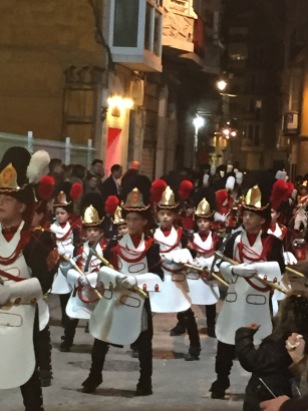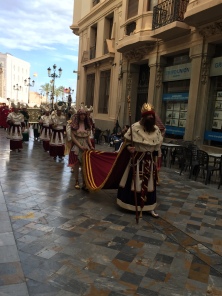Easter week is filled with processions and Cartagena is the first to get under way in Spain. Ian’s Mum and Dad, John and Irene, arrived on 22nd so they were able to experience it along with us.
The processions are staged by the “Brotherhoods” of which there are four in Cartagena. The first procession, Viernes de Dolores, began on Friday 23rd March at 3.30am. Yes you have read that correctly, well as you have guessed we didn’t make that one. As well as being the start of Holy Week it is also the Feast Day of the Patron Saint of Cartagena. The first procession we watched was the “Floral Offering”. Mainly women and children dressed in traditional regional costume who make floral offerings to the patron of Cartagena. The flowers are placed outside the Iglesia de la Caridad. Again what strikes you most, as with the carnivals, that it is very much a family affair from babes in arms to elderly people.
There were two further processions this evening. The first was the “Processional Via Crucis”.
The main procession the “Procession Santisimo Cristo de la Misericordia” which began at 9 o’clock. Nothing starts very early in Spain. This lasted for just under three hours. This was our first sighting of the brotherhoods, some of whom wear pointed hoods that cover their heads and faces, so all you can see is their eyes. It is a bit unnerving. They all wear the same colours which consists of a robe, sash around the waist, a cloak, hood and sandals. The reason for the hoods is that those wearing them are repenting their sins in public but want to remain anonymous.
The Brotherhoods are divided into smaller groups who are in charge of one of the tronos (floats). The order is three members of the group who walk side by side, followed by two lines of members who march in time to the beat of the drums.
Following behind each of the groups is a music band and the drummers and finally the trono. Some are carried and others are pushed along from inside. You know from a distance if a trono is being carried or pushed along as if it’s being carried you can see it swaying from side to side. They have to manoeuvre these enormous floats around some very small winding streets. When you hear a bell ring the “portapasos” (float carriers) stop, a second bell sounds and they gently put the trono down. And in reverse when the bell goes they stand ready in place, second bell, they lift the trono and off they go again. When you see the size of these things you can understand why they have to stop every few minutes to rest. The tronos are carried by groups of men and women.
The processions are unique to Cartagena as they are quite regimented, an influence of Cartagena’s military and naval background. So in amongst the brotherhoods are groups of military.
Domingo de Ramos (Palm Sunday)
The Roman Soldiers march around the city in the morning. The Romans ruled over Cartagena following the Battle of Cartagena in 209BC.
As it was Palm Sunday of course nearly everyone carried a palm.

Watching the procession, one of many.

The churches are not always open however walking along Calle Mayor on Sabado Santa (Easter Saturday) the Virgin Mary had been brought out on display for all to see.

We walked past the Basilica de le Caridad on many occasions but we only came across its doors open on Easter Saturday evening. So of course we took the opportunity to go in and have a look.
The processions are mesmerising. The photos are just a small selection to give you a flavour as the processions went on for quite a few hours. We feel very fortunate to be in Spain during this time as it was AMAZING experience.
Spain – March 2018












































